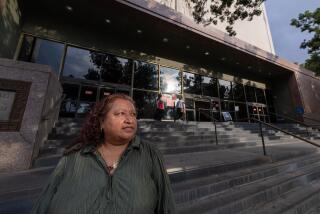Commentary : Stop Two-Tiered Justice : Courts: Access to faster and cheaper dispute resolution shouldn’t be just for the rich.
- Share via
Last February, California Chief Justice Ron George appointed two subcommittees to measure the quality of justice in the state: one to examine the quality of judicial service, the other to assess the impact of Alternative Dispute Resolution on the judicial system. Ironically, the success of alternative dispute resolution may be one of the reasons that the quality of judicial service is declining.
The first report, delivered to the judicial council in April, contained bad news: The job of being a California judge is no longer as appealing as it once was. Salaries lag far behind what federal judges are paid, as well as the salaries paid to judges in many other states. The deputy district attorneys and public defenders appearing in California courtrooms often earn larger salaries than the judge. Crushing workloads have steadily increased, and the judicial retirement system actually discourages judges from continuing in office after they are eligible to retire.
Our most-experienced judges are retiring as soon as they qualify, many of them to pursue lucrative opportunities for “private” judging. The Subcommittee on the Quality of Judicial Service recommended higher salaries, longer vacations, paid sabbaticals and improvements in the retirement system for California judges to keep them on the bench longer.
The second report shows private dispute resolution is thriving. Some will greet the report as good news, but those who have watched our system of public education in California decline from one of the best in the country to one of the worst will find cause for alarm.
Private ADR caseloads are growing at a rate of 15% per year. The total private ADR caseload in California is estimated at 95,500 cases for 1997. While total statewide filings in superior and municipal courts exceeded 1.6 million that year, the 5.4% of disputes going “private” are higher value cases, with more at stake.
The reasons “private” judging thrives are obvious to most litigants who can afford this alternative. It’s faster, because you don’t have to wait in line for a courtroom. It’s actually cheaper if you’re paying big bucks to your attorney. While private judges are paid high hourly rates, the lawyers are billing fewer hours. The decision is final, without endless appeals. The process is completely private, with the public and the press excluded from the courtroom. (Three weeks ago, the California Supreme Court ruled that the press cannot be excluded from civil trials in public courtrooms.) And most important, the autonomy of the parties is respected. You can choose your judge and the parties control the judge’s agenda.
The more cases siphoned off into private judging, the fewer cases our overburdened public courts have to handle. Why is that a problem? The problem comes when we ask where the public support will come from to raise judicial salaries and perks, and maintain the quality of our public judicial system.
We confront the same dilemma that has haunted our public schools for three decades. When wealthy parents who could afford private school tuition pulled their kids out of the public schools, the base of support essential for the funding of public education quickly eroded. Public schools were left with the “captives,” who couldn’t afford to opt out, and resented it. School bonds started losing in elections, in part, because those who influence election results no longer saw themselves as “stakeholders” in public eduction.
Our system of public justice may be headed down the same spiral. As wealthy litigants and those seeking a less contentious forum to resolve their disputes turn to private judges, the public court system is left with the toughest disputes to resolve and less resources to accomplish the task. A growing proportion of the public caseload is pro se litigants, who are representing themselves, and overzealous litigants whose lawyers can’t get them to agree on anything.
It took those in public education a long time to realize that their monopoly did not mean they did not have to compete. Public schools now strive to offer parents and students more choices, emulating the private schools across the street. Public judges have to learn the same lesson.
The report of the subcommittee on ADR recommends a host of changes to make our public courts more user-friendly: Every litigant would be informed about the ADR alternatives, with their advantages and disadvantages. A list of ADR providers and their fees could be supplied, and providers would be encouraged to offer pro bono or limited-fee services for low-income litigants. Listed providers would agree to abide by court-approved ethical standards.
Access to faster and cheaper resolution of disputes should not be limited to wealthy litigants, and the proposals to make ADR available in every case in which the litigants want it should be implemented without delay. Everyone is a stakeholder in our system of public justice. If we allow the system to evolve into one in which “first class” litigants go private, while the “public” litigants remain in overcrowded and oppressive “coach class” courtrooms, we will betray the promise inscribed above the courthouse steps: Equal justice for all.
More to Read
Get the L.A. Times Politics newsletter
Deeply reported insights into legislation, politics and policy from Sacramento, Washington and beyond. In your inbox twice per week.
You may occasionally receive promotional content from the Los Angeles Times.










